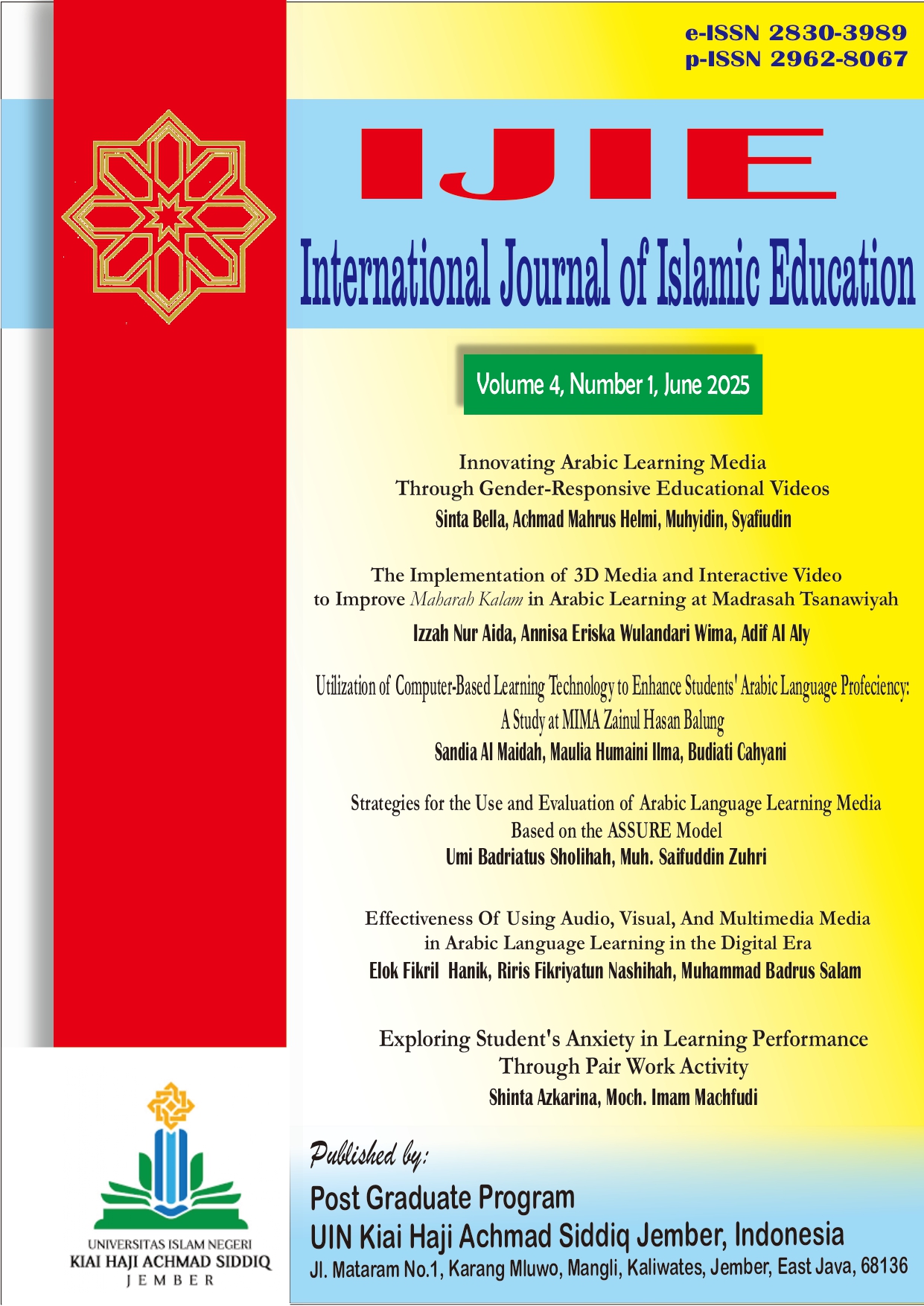Strategies for the Use and Evaluation of Arabic Language Learning Media Based on the ASSURE Model
DOI:
https://doi.org/10.35719/ijie.v4i1.2305Keywords:
Arabic Language Learning Media, ASSURE Model, Strategies and Evaluation.Abstract
This research is a qualitative study, with data collection techniques include documentation, interviews, and observation. The instructional development model used is the ASSURE model, which recommends six main activities in instructional planning: (A) Analyze the general characteristics of the target group.(S) State or formulate the learning objectives. (S) Select, modify, or design and develop appropriate materials and media. (U) Utilize the materials and media. (R) Require learner participation or responses. (E) Evaluate the learning process. There are various types of learning evaluation, including formative and summative evaluation. Formative evaluation is the process of collecting data during the development of instructional media with the aim of determining its feasibility. This evaluation includes several instruments that serve as parameters for assessing the quality of the media from the perspectives of content, educational value, and technical quality. Summative evaluation, is used to determine the effectiveness of the instructional media after its implementation. This includes written tests, performance assessments and practicum, portfolio assessments, project evaluations, and rubric-based assessments.
References
Diniyyah, Pendidikan, and Formal Pdf. “Implementasi Evaluasi Sumatif Pembelajaran Bahasa Arab Di” 2, no. January (2025): 218–27.
Evi Nurus Suroiyah. “EFEKTIVITAS PENGGUNAAN MEDIA FILM DALAM PEMBELAJARAN BAHASA ARAB Di TPQ SUNAN MURIA BENDO JABUNG MALANG.” Muhadasah: Jurnal Pendidikan Bahasa Arab 2, no. 2 (2020): 241–54. https://doi.org/10.51339/muhad.v2i2.210.
Fahyuni.E.F, 2011. “Fakultas Agama Islam Universitas Muhammadiyah Sidoarjo Tahun Ajaran 2017” 1, no. 1 (2017): 5–6.
Fauzi, Y, S Lisnawati, and Rofi’ah. “Strategi Penggunaan Media Pembelajaran Berbasis Video Terhadap Minat Belajar Siswa Pada Mata Pelajaran Sejarah Kebudayaan Islam.” Annual Conference on Islamic Education and Social Sains (ACIEDSS) 1, no. 1 (2019): 41–49.
Furoidah, Asni. “Media Pembelajaran Dan Peran Pentingnya Dalam Pengajaran Dan Pembelajaran Bahasa Arab.” Al-Fusha : Arabic Language Education Journal 2, no. 2 (2020): 63–77. https://doi.org/10.36835/alfusha.v2i2.358.
Kalpokaite, Neringa, and Ivana Radivojevic. “Demystifying Qualitative Data Analysis for Novice Qualitative Researchers.” Qualitative Report 24, no. 13 (2019): 44–57. https://doi.org/10.46743/2160-3715/2019.4120.
Khair, Miftahul, and Muhammad Jundi. “Uncovering Innovations in Instructional System Design Models for Arabic Language Learning” 01, no. 01 (2024).
Mayasari, Annisa, Windi Pujasari, Ulfah Ulfah, and Opan Arifudin. “Pengaruh Media Visual Pada Materi Pembelajaran Terhadap Motivasi Belajar Peserta Didik.” Jurnal Tahsinia 2, no. 2 (2021): 173–79. https://doi.org/10.57171/jt.v2i2.303.
Model, Learning, and Learning Outcome. “Keywords : Learning Model, ASSURE, and Learning Outcome” 2, no. 7 (2024): 652–60.
Muhimmatul Choiroh. “Evaluasi Pembelajaran Bahasa Arab Berbasis Media E-Learning.” Jurnal Naskhi: Jurnal Kajian Pendidikan Dan Bahasa Arab 3, no. 1 (2021): 41–47. https://doi.org/10.47435/naskhi.v3i1.554.
Nugrawiyati, Jepri. “Media Audio Visual Dalam Pembelajaran Bahasa Arab.Pdf” 6 (2018).
Santidar, Ario Dwi. “Pengembangan Game Edukasi Baamboozle Berbasis Assure Untuk Fikih Kelas X Di MA Hidayatul Insan” 3, no. 1 (2025).
Sidiq, Maulid Anwar. “Efektifitas Penggunaan Media Gambar Dalam.” Jurnal AS-SAID 6, no. 2 (2019): 41–48.
Tarbiyah, Fakultas. “PENGGUNAAN MEDIA AUDIO-VISUAL PADA MATA PELAJARAN BAHASA ARAB Intan Nurhasana” 2, no. 2 (n.d.): 2021.
Wijayanto, Pradika Adi, Muhammad Fatkhur Rizal, Elok Ayu Khumaerok Ertika Subekti, and Tiara Annisa Novianti. “Pentingnya Pengembangan Geography Virtual Laboratory (Geo V-Lab) Sebagai Media Pembelajaran Litosfer.” Jurnal Pendidikan (Teori Dan Praktik) 3, no. 2 (2018): 119. https://doi.org/10.26740/jp.v3n2.p119-125.










